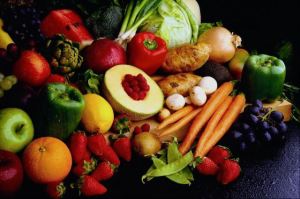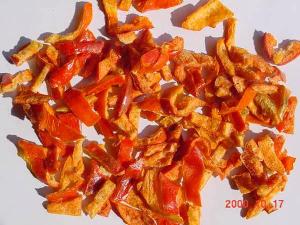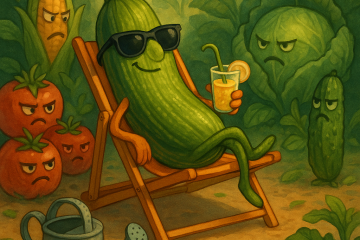I’ve conducted over 100 food storage evaluations over the last year and a half, and while there are a myriad of issues and common errors that many make, one thing that concerns me the most is a lack of emphasis on the storage of fruits and vegetables. These items are critical in fulfilling the body’s need for fiber, vitamins and minerals. The best weapon you can have in an emergency is your health and fruits and veggies are a key to providing this. A focus on fruits and veggies has a great deal of lifesaving merit.
Given that many of us utilize fresh or frozen produce, we tend to overlook the need for canned or freeze dried sources to meet those nutritional needs in the event of an emergency. We’re constantly pummeled with “wheat and water” admonitions for food storage, but we rarely hear the need to be mindful of fruits and veggies. So how many servings do you need and in what form should you store it? Given the variety of emergencies that can affect us, relying solely on a small garden or what’s in our freezer to provide us with this vital nutrition is not a good game plan. You really can’t afford to have this vital source of nutrition off of your radar. You simply must focus on having 3 servings a day of fruits and veggies, especially during an emergency.
I’m a big fan of freeze dried fruits and veggies. In number ten cans, quality freeze-dried produce will last 20 to 30 years. Even better, if you are able to get it on sale, it needn’t be something that you obtain just for emergencies. For example, I regularly acquire freeze dried spinach and diced red and green peppers. When I’m making an omelet, I take a couple of spoonfuls of spinach and mix it in. Not only have I saved myself time by not cleaning and cutting the veggies, but this way I know that I won’t have to throw veggies out later. When I’m making a spaghetti sauce or a casserole, I simply add a dash of my peppers for flavor. This is actually a LOT less expensive than if I were to go to the store, pay for the produce, clean it, dice it, and then hope that I’ve got more uses for the remainder before it goes bad. The same holds true for fruits. In fact, I regularly find myself munching on the fruits out of the can without even the need to reconstitute them. They are a delightful snack this way. Freeze-dried pineapple, blueberries, apples and strawberries are yummy! And they are much easier on your blood sugar than the sweets you will inevitably crave in an emergency.
Understand that there’s a big difference between freeze-dried and dehydrated foods. Dehydrated fruits and veggies lose the majority of their nutritional value, not to mention that they don’t always taste the best. Whereas freeze-dried produce keeps 90% of its nutritional value, and with an easy bit of reconstituting can be indiscernible from fresh produce in your dishes. In my opinion the taste of freeze-dried goods are just as good, if not better than the real thing. It’s almost like the freeze-drying process compounds the flavors.
Next, canned fruits and veggies. I don’t mind canned fruits, but personally, I’m not a big fan of some veggies from the can. I love fresh produce and the canned goods just don’t cut it for me. That said, I’ve learned to live with them in a casserole or when mixed in with something else. But I’m also mindful that in an emergency, the nutritional value is critical for those not-so-green goodies in the can. Obviously, taking on the lost art of canning is a GREAT idea. Chances are that the canners your grandmothers used still work perfectly today, but other canners have progressed significantly in our time that provide more safety features. Plus, Mason jars and lids are very, very affordable. Learning how to can allows you the luxury of making the most of a great sale on produce! There’s very little that you can’t can and put away for a rainy day. It’s not nearly as time-consuming as you may remember as a child thanks to the advance technology available. Consider that you can also can fruits and veggies in a solar oven without heating up your kitchen or being fearful of the hissing that your canner makes. I’ve even known women in Arizona and Texas who have canned their produce simply by putting it in jars out on their hot patio. Now how easy is that!?
Lastly, sprouting. Yes, wheat is a starch, but when you sprout it (as well as other grains and legumes) it becomes a high quality fresh vegetable! Consider also that in the event of an emergency, water will be a highly valuable commodity so using large amounts of water to preserve your vegetable garden may not be realistic. However, sprouting is very easy to do, indoors or out, and it requires a minimal amount of water. Most sprouted items increase in nutritional value by over 500%! So while you’re storing up your wheat, be sure to consider the supplies necessary to sprout your wheat into a good supply of vegetable source as well. When your wheat does sprout, it’s also a great indicator that your wheat is in fine condition for consumption. If it doesn’t sprout, it means that it’s lost a lot of its nutrients during storage. While it can still be used for flatbreads and such, it’s not going to do much more than fill you up when you’re hungry.
Word to the wise: don’t forget to store your fruits and veggies!
To see our upcoming event schedule, click here
Check out our inhome-course programs
Subscribe to Preparedness Pro today and never miss a thing!
For any questions or comments on this article, please leave a comment on the blog site so that everyone can benefit!
Copyright Protected 2009, Preparedness Pro and Kellene. All Rights Reserved. No portion of any content on this site may be duplicated, transferred, copied, or published without written permission from the author. However, you are welcome to provide a link to the content on your site or in your written works.






32 Comments
amber · June 12, 2009 at 5:15 pm
Being of a more carnivore mindset, this was an excellent reminder to me to not forget my veggies!!! 🙂
amber · June 12, 2009 at 5:15 pm
Being of a more carnivore mindset, this was an excellent reminder to me to not forget my veggies!!! 🙂
Sup3D · June 12, 2009 at 9:13 pm
Fantastic article! What sources do you recommend for freeze dried foods? I know you can get it from many places, but are there any particular brands you recommend and websites to order it from? Thanks in advance.
Sup3D · June 12, 2009 at 9:13 pm
Fantastic article! What sources do you recommend for freeze dried foods? I know you can get it from many places, but are there any particular brands you recommend and websites to order it from? Thanks in advance.
matthiasj · June 12, 2009 at 10:20 pm
Great post Kellene. I love veggies. Freeze-dried is a great alternative to fresh.
matthiasj · June 12, 2009 at 10:20 pm
Great post Kellene. I love veggies. Freeze-dried is a great alternative to fresh.
Abraham · June 13, 2009 at 2:40 am
French cut green beans in the can is the ultimate comfort food to me. It reminds me of growing up.
Abraham · June 13, 2009 at 2:40 am
French cut green beans in the can is the ultimate comfort food to me. It reminds me of growing up.
Jen · June 15, 2009 at 11:59 am
Kellene,
Just another reason to store veggies — global cooling. Yes, we’re now going the “other” way.
http://www.telegraph.co.uk/comment/columnists/christopherbooker/5525933/Crops-under-stress-as-temperatures-fall.html
Yes, French cut green beans do taste different in the can. Must be all of the sodium!
Jen · June 15, 2009 at 11:59 am
Kellene,
Just another reason to store veggies — global cooling. Yes, we’re now going the “other” way.
http://www.telegraph.co.uk/comment/columnists/christopherbooker/5525933/Crops-under-stress-as-temperatures-fall.html
Yes, French cut green beans do taste different in the can. Must be all of the sodium!
FCG · June 17, 2009 at 6:57 am
The idea that fruit and vegetables are necessary for health does need to be examined. It may be worth looking in to pemmican and it’s historical uses as a survival food particularly in regions where plants are sparse to non-existant.
FCG · June 17, 2009 at 6:57 am
The idea that fruit and vegetables are necessary for health does need to be examined. It may be worth looking in to pemmican and it’s historical uses as a survival food particularly in regions where plants are sparse to non-existant.
The Prudent Homemaker · June 25, 2009 at 4:50 pm
We’ve lived primarily on our food storage and our garden the last couple of years.
Something that really helps is having a variety of fruits and vegetables. After a while, you don’t want to eat the same ones anymore.
It also helps to have a garden. Our first year on food storage, our garden did not do well, and we relied on what fruits and vegetables we had stored. It was nice to be able to have fruit; you would not want to live for a few years with no fruits and vegetables, nor would it be good for you.
A garden makes a big difference. I was able to have lettuce, spinach, chard, artichokes, and asparagus this year in addition to the green beans, corn, and home-canned (and also dried fruits) that we have.
The Prudent Homemaker · June 25, 2009 at 4:50 pm
We’ve lived primarily on our food storage and our garden the last couple of years.
Something that really helps is having a variety of fruits and vegetables. After a while, you don’t want to eat the same ones anymore.
It also helps to have a garden. Our first year on food storage, our garden did not do well, and we relied on what fruits and vegetables we had stored. It was nice to be able to have fruit; you would not want to live for a few years with no fruits and vegetables, nor would it be good for you.
A garden makes a big difference. I was able to have lettuce, spinach, chard, artichokes, and asparagus this year in addition to the green beans, corn, and home-canned (and also dried fruits) that we have.
Jennifer · July 28, 2009 at 3:00 pm
I don’t know the first thing about sprouting but I want to learn. Do you have any resources (books, sites, info, etc.) that you would suggest?
Jennifer · July 28, 2009 at 3:00 pm
I don’t know the first thing about sprouting but I want to learn. Do you have any resources (books, sites, info, etc.) that you would suggest?
Kellene · July 28, 2009 at 3:28 pm
For starters…buy the Easy Sprouter and some sprouting seeds at your local health food store. Have instant success with that and then start really studying up on it. That’s my two cents.
Kellene · July 28, 2009 at 3:28 pm
For starters…buy the Easy Sprouter and some sprouting seeds at your local health food store. Have instant success with that and then start really studying up on it. That’s my two cents.
kerricodi · September 10, 2009 at 5:41 am
Wow I love this article, I toatlly agree with more veggies and fruit, we are primarily vegatarians, except once or twice a week. I am excited to learn how to sprout! Thanks for that great information!
kerricodi.wordpress.com
kerricodi · September 10, 2009 at 5:41 am
Wow I love this article, I toatlly agree with more veggies and fruit, we are primarily vegatarians, except once or twice a week. I am excited to learn how to sprout! Thanks for that great information!
kerricodi.wordpress.com
PAF · September 29, 2012 at 5:29 pm
Kellene, I buy Ocean Spray dried cranberries in large bags. Could I use my Food Saver to seal these and extend the shelf life?
Kellene Bishop · September 29, 2012 at 8:31 pm
I don’t believe so. I’d dehydrate them first and then seal them if it were me. I know they are hard, but they are still a juicy fruit inside.
PAF · September 29, 2012 at 5:29 pm
Kellene, I buy Ocean Spray dried cranberries in large bags. Could I use my Food Saver to seal these and extend the shelf life?
Kellene Bishop · September 29, 2012 at 8:31 pm
I don’t believe so. I’d dehydrate them first and then seal them if it were me. I know they are hard, but they are still a juicy fruit inside.
Comments are closed.